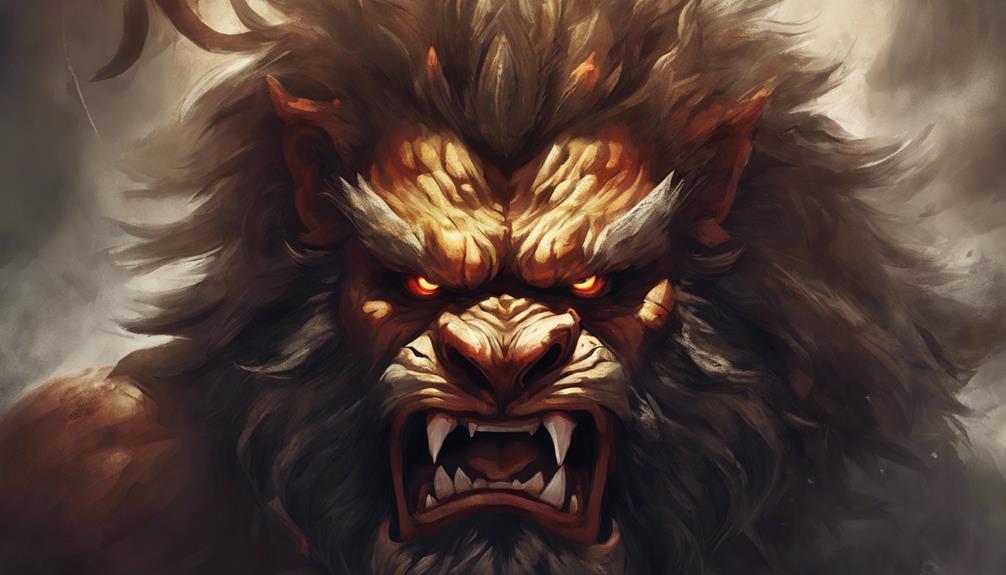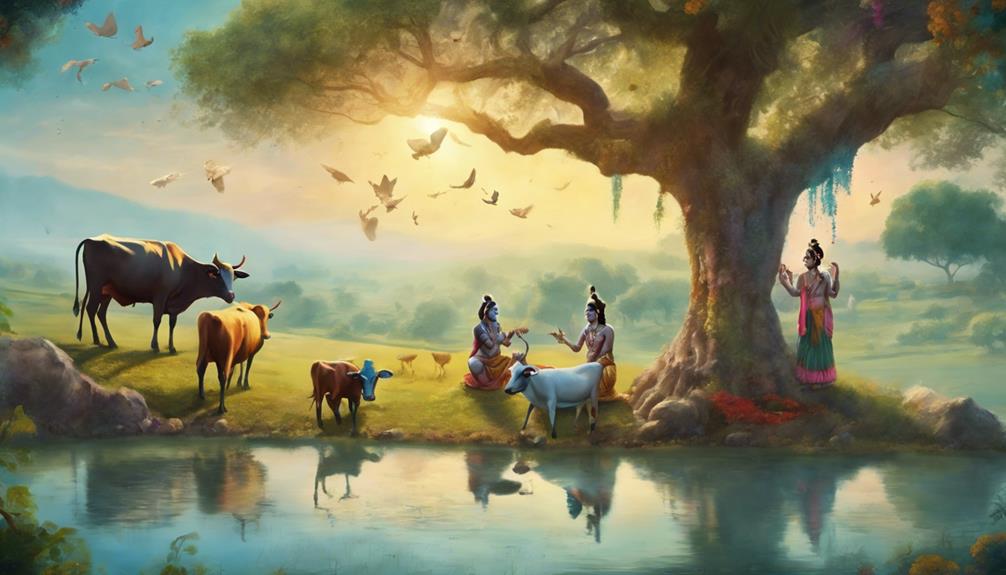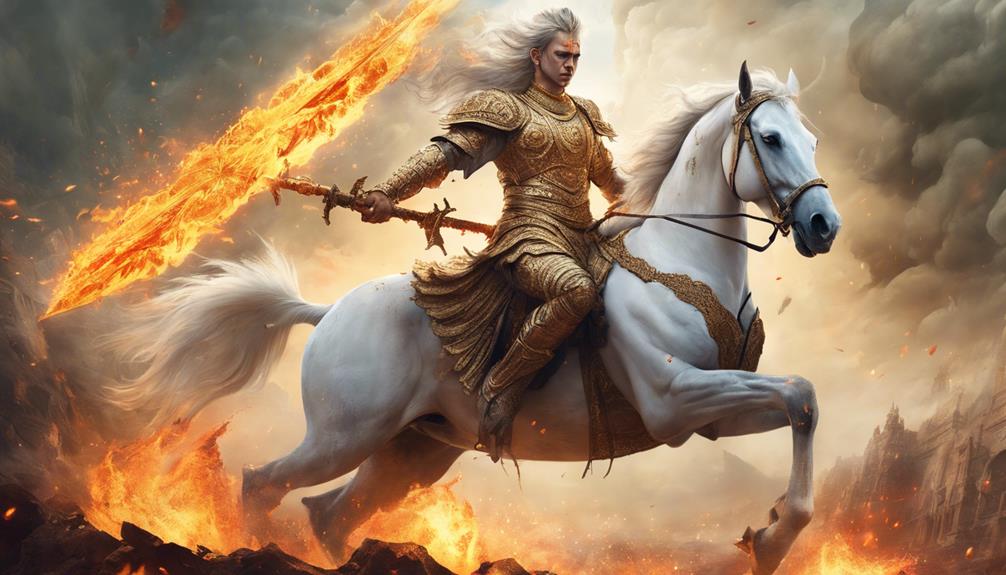Explore the profound stories of Dashavatara, the ten divine avatars of Vishnu. Each avatar signifies cosmic principles like protection, justice, righteousness, enlightenment, and transformation. From Matsya safeguarding sages to Kalki heralding a new era, these avatars embody divine qualities that guide the world. Each tale reveals a deeper understanding of the universe's intricate balance and the eternal struggle between good and evil, offering insight into the timeless wisdom of Vishnu's avatars.
Table of Contents
Key Takeaways
- Matsya Avatar saved sages and Vedas from a deluge, symbolizing protection and preservation.
- Kurma Avatar aided in churning the ocean, signifying stability and resilience in times of crisis.
- Varaha Avatar rescued the Earth from the depths of the ocean, illustrating divine power and protection.
- Narasimha Avatar vanquished a demon to restore cosmic balance, showcasing justice and love.
- Vamana Avatar subdued a tyrannical king, demonstrating humility and cosmic equilibrium.
Matsya Avatar
The Matsya Avatar, the first incarnation of Lord Vishnu, is a pivotal moment in Hindu mythology where Vishnu takes the form of a fish to save the world from a catastrophic flood. This divine transformation holds profound symbolic significance, linking back to the aquatic origins of life on Earth. The fish symbolism represents fertility, life, and the primordial waters from which all creation emerged. In the creation myth, Matsya's cosmic significance is undeniable as it not only safeguards the sages and the Vedas but also guarantees the continuity of life on Earth.
The Matsya Avatar serves as a protector and preserver of the universe, showcasing Vishnu's role as the sustainer of dharma. Through this avatar, Vishnu demonstrates his willingness to take any form necessary to restore balance and order to the cosmos. The tale of Matsya highlights the importance of adaptability and sacrifice in the face of adversity, emphasizing the eternal nature of Vishnu's compassion and divine intervention in times of crisis.
Kurma Avatar
As you start to uncover the tale of Kurma Avatar, you'll reveal the significance of Kurma's protective role in Hindu mythology.
This avatar showcases the pivotal moment when Vishnu took the form of a turtle to aid in the churning of the ocean.
Explore deeper into the story to understand the symbolism behind Vishnu's turtle form and its role in preserving the balance of the universe.
Kurmas Protective Role
With unwavering determination and profound purpose, Kurma Avatar emerged to fulfill his protective role in the grand tapestry of the Dashavatara stories. Kurma's wisdom and protection were symbolized through his manifestation as a giant turtle, signifying stability and resilience.
The turtle symbolism holds great significance, representing the idea of a strong foundation that supports the divine cosmic order. Kurma Avatar's portrayal as a turtle showcases the importance of protection and steadfastness in times of turmoil, reminding us to stay grounded amidst chaos.
Through his presence, Kurma Avatar exemplifies the essence of guardianship and the need for a steady hand to guide and shield against adversities, embodying the virtues of patience, endurance, and unwavering strength.
Churning of Ocean
Emerging from the depths of divine purpose, Kurma Avatar's pivotal role in the grand narrative unfolds in the monumental event known as the Churning of the Ocean. This cosmic episode symbolizes profound meanings beyond the physical act of churning.
The ocean, within this setting, represents the vast cosmic consciousness, and the churning signifies the eternal quest for knowledge and enlightenment. Kurma Avatar's presence during this mythological event highlights the divine purpose of maintaining cosmic balance.
As Vishnu took the form of a turtle to support the churning, it symbolizes the importance of stability and patience in the face of challenges. The Churning of the Ocean holds significant mythological importance, emphasizing the eternal struggle between good and evil and the continuous quest for cosmic equilibrium.
Vishnus Turtle Form
In the grand tapestry of divine incarnations, the Turtle Form of Vishnu, known as Kurma Avatar, embodies unwavering support and patience in the cosmic narrative. This avatar symbolizes the foundation on which the universe rests, showcasing the importance of stability and resilience.
The Kurma Avatar carries profound symbolic significance, portraying hidden meanings of steadfastness and the ability to endure challenges. From an evolutionary interpretation, this form can be seen as a representation of adaptation and survival, mirroring the scientific perspective of species evolving to thrive in various environments.
Varaha Avatar
Varaha Avatar, the third incarnation of Lord Vishnu, embodies the divine power and protection as he manifests in the form of a mighty boar. This avatar holds significant symbolism, representing the eternal struggle between good and evil. Varaha's rescue mission symbolizes the cosmic battle between the forces of chaos and order.
The story goes that Varaha dived into the cosmic waters to rescue Goddess Earth, who'd been submerged into the depths by the demon Hiranyaksha. The rescue mission of Varaha signifies the protection of righteousness and the restoration of balance in the universe.
In this form, Vishnu's immense power and dedication to preserving dharma are displayed vividly. Varaha's fierce battle with the demon showcases his unwavering commitment to upholding cosmic order. Through this avatar, Vishnu demonstrates his willingness to go to great lengths to protect and restore harmony in the world, serving as a beacon of hope and strength for his devotees.
Narasimha Avatar

With ferocious grace, Narasimha Avatar, the fourth embodiment of Lord Vishnu, manifests in a unique form that symbolizes the convergence of divine power and cosmic justice. Narasimha's rage is legendary, as he emerged from a pillar to protect his devotee, Prahlada, from his tyrannical father, Hiranyakashipu.
The story goes that Hiranyakashipu, granted with a boon of invincibility, believed himself to be immortal. However, Vishnu, in his Narasimha form, proved this wrong. Half lion and half man, Narasimha tore apart Hiranyakashipu at dusk, on the threshold of a courtyard, neither indoors nor outdoors, using his claws. This act showcases the depth of Narasimha's commitment to upholding righteousness and protecting his devotees.
Prahlada's unwavering faith in Vishnu despite his father's cruelty exemplifies the enduring bond between a devotee and the divine. Narasimha Avatar stands as a symbol of the relentless pursuit of justice and the boundless love and protection that Vishnu bestows upon those who seek refuge in him.
Vamana Avatar
As you explore the Vamana Avatar, you'll discover the intriguing tale of Vishnu's transformation into a dwarf.
This story is intricately woven with the legend of the Trivikrama feet measuring the cosmos.
The Vamana Avatar holds profound significance in Hindu mythology, symbolizing divine wisdom and humility.
Dwarf Incarnation Story
In the ancient Hindu scriptures, the tale of Vishnu's Vamana Avatar unfolds with intrigue and divine purpose. The Dwarf Incarnation Story symbolizes Vishnu's humility and the idea that even the smallest form can hold immense power and wisdom.
Vishnu, disguised as a dwarf Brahmin named Vamana, approached the demon king Bali during a grand sacrifice. Vamana requested only three paces of land, yet with each step, he measured the entire universe, revealing his cosmic form.
This story holds deep cultural interpretations, showcasing themes of righteousness, deception, and cosmic balance. The Vamana Avatar teaches that true strength lies not in physical stature but in moral integrity and the ability to uphold dharma, the cosmic order of the universe.
Trivikrama Feet Measure
Effortlessly spanning the cosmos, Vamana Avatar's Trivikrama feet symbolize the boundless reach of divine grace and cosmic balance.
The cosmic measurements of Trivikrama's feats depict Vishnu's omnipotence and his ability to transcend all dimensions.
The symbolic significance of these measurements lies in Vishnu's strides, which not only cover the material universe but also extend beyond the physical domain into the spiritual and metaphysical planes.
Through the act of measuring the three worlds in a single step, Vishnu demonstrates his supreme authority and control over the universe.
Each stride taken by Trivikrama serves as a reminder of the interconnectedness of all existence and the harmonious equilibrium maintained by Vishnu in his various avatars.
Parashurama Avatar
Known for his fierce determination and unwavering dedication, Parashurama Avatar embodies the essence of divine wrath and relentless pursuit of justice**. Parashurama's wrath is legendary, as he wielded his axe to rid the world of arrogant Kshatriyas who abused their power. Despite his fierce nature, Parashurama was also a revered teacher, imparting invaluable lessons to his disciples. His teachings emphasized the importance of upholding dharma** and righteousness, inspiring many to lead virtuous lives.
Parashurama's story serves as a reminder of the consequences of straying from the path of righteousness. His unwavering commitment to upholding justice and punishing the wicked showcases the importance of maintaining moral order in society. Through his actions, Parashurama demonstrates the significance of standing up against injustice and fighting for what's right.
As you immerse into the tales of Parashurama Avatar, you're drawn into a world where divine fury meets profound wisdom, leaving a lasting impression of the power of determination and the pursuit of justice.
Rama Avatar
Embodying grace and virtue amidst the tumult of divine incarnations, Rama Avatar stands as the epitome of righteousness and unwavering devotion to duty. Rama's exile from Ayodhya, accompanied by his wife Sita and loyal brother Lakshmana, serves as a proof of his commitment to honor his father's word. Throughout his exile, Rama faces numerous challenges and battles, displaying unparalleled courage and moral fortitude.
The most poignant event in Rama Avatar's story is Sita's abduction by the demon king Ravana. The abduction leads to an epic rescue mission where Rama, aided by the devoted monkey god Hanuman and an army of Vanaras, crosses oceans and faces formidable foes to rescue his beloved Sita. The eventual triumph of good over evil in the rescue of Sita showcases Rama's unwavering dedication to upholding dharma and righteousness.
Rama Avatar's tale isn't just a story of exile and battles but a profound saga of love, sacrifice, and the eternal fight against injustice. His unwavering commitment to duty and virtue continues to inspire generations, making Rama Avatar an enduring symbol of righteousness and devotion.
Krishna Avatar

In the divine chronicles of the Dashavatara, the Krishna Avatar emerges as a multifaceted embodiment of cosmic playfulness and profound wisdom. Krishna's childhood antics, such as stealing butter and playing pranks on the village girls, showcase his endearing charm and mischievous nature. Despite these playful traits, Krishna's divine love for all beings shines through in his interactions and teachings.
Krishna's divine love is exemplified in his relationships with devotees like Radha and the Gopis, where his unconditional affection and devotion inspire profound spiritual devotion. Through his melodious flute playing and enchanting dance performances, Krishna captivates hearts and souls, drawing all towards the path of righteousness and divine love.
As the Supreme Personality of Godhead, Krishna's teachings in the Bhagavad Gita reflect his deep wisdom and philosophical insights, guiding Arjuna and humanity towards their righteous duties and spiritual liberation. The Krishna Avatar symbolizes the eternal dance of love and wisdom, enchanting devotees through his divine play and profound teachings.
Buddha Avatar
The divine tapestry of the Dashavatara unfolds further with the manifestation of the Buddha Avatar, a profound embodiment of enlightenment and compassion in human form. The Buddha Avatar signifies a pivotal moment in the cycle of Vishnu's avatars, representing the enlightening journey towards spiritual awakening. Through the Buddha Avatar, Vishnu sought to guide humanity towards a path of inner reflection and liberation from suffering, encapsulating the essence of Buddha's teachings on compassion, non-violence, and mindfulness.
In the historical context, the Buddha Avatar emerged during a period of societal upheaval and spiritual seeking in ancient India. Siddhartha Gautama, the historical Buddha, revolutionized prevailing beliefs and practices, leaving an indelible impact on the spiritual landscape of the region. His teachings transcended social barriers, resonating with people across diverse backgrounds and beliefs, fostering a legacy of profound wisdom and ethical conduct.
The Buddha Avatar serves as a beacon of light, illuminating the way towards inner peace and universal harmony, making it a cherished chapter in the grand narrative of Vishnu's avatars.
Kalki Avatar

As you delve into the concept of Kalki Avatar, you'll discover the divine purpose behind this manifestation, believed to be the herald of a new era.
The prediction of destruction that comes with Kalki's arrival signifies the purifying of the world from malevolent forces, paving the way for a revitalized existence.
This culmination marks the conclusion of the Kali Yuga, indicating a shift to a more enlightened age in Hindu cosmology.
Kalkis Divine Purpose
With a resolute mission shrouded in mystery and divine purpose, Kalki Avatar emerges as the harbinger of transformation in Hindu mythology.
Kalki's mission is intricately tied to the concept of divine intervention, where he's foretold to appear at the end of the Kali Yuga, the current age of darkness and decline in Hindu cosmology.
Kalki is believed to arrive riding a white horse, brandishing a blazing sword, symbolizing his role as the destroyer of evil and the protector of righteousness.
His purpose is to cleanse the world of corruption and restore Dharma, the cosmic order.
Kalki's arrival signifies the end of one cycle and the beginning of a new era, where virtue and justice prevail under his divine guidance.
Prophecy of Destruction
Emerging as a harbinger of transformation deeply rooted in prophecy, Kalki Avatar embodies the imminent destruction of evil and the restoration of cosmic balance in Hindu mythology.
The prophecy surrounding Kalki Avatar foretells a time of great turmoil and chaos, where adharma (unrighteousness) prevails and humanity suffers. Kalki, the tenth and final avatar of Vishnu, is prophesied to appear riding a white horse with a blazing sword to bring an end to the dark age of Kali Yuga.
His purpose is to cleanse the world of negativity, ignorance, and corruption, paving the way for a new era of righteousness and harmony.
The destruction that Kalki brings isn't merely physical but also metaphysical, symbolizing the eternal battle between good and evil.
End of Kali Yuga
In the grand tapestry of Hindu mythology, the culmination of Kali Yuga heralds the arrival of Kalki Avatar, marking the definitive end of an era plagued by darkness and chaos. Kali Yuga, the final stage in the cosmic cycle, is characterized by moral degradation, strife, and societal turmoil.
Predictions foretell that during this period, righteousness will wane, leading to widespread corruption and spiritual apathy. The advent of Kalki Avatar is prophesied as the harbinger of the end times, where divine intervention will restore balance and righteousness.
Kalki, the divine warrior, is said to appear riding a white horse, wielding a blazing sword, ready to vanquish evil forces and usher in a new era of peace and enlightenment. His arrival signifies the cyclical nature of time and the eternal struggle between good and evil in Hindu cosmology.
Frequently Asked Questions
What Is the Significance of Each of the Dashavatara Avatars in Hindu Mythology?
Explore the significance of each Dashavatara avatar in Hindu mythology. Discover the profound lessons, common themes, diverse interpretations, and cultural impact. Uncover the influence these avatars wield, shaping beliefs and practices over centuries.
Are There Any Common Themes or Lessons That Can Be Drawn From the Stories of the Ten Avatars of Vishnu?
Themes, lessons, and symbolism from the ten avatars of Vishnu offer profound insights into Hindu mythology. Their interpretations shape beliefs, influence rituals, and inspire cultural narratives. The avatars' stories resonate with timeless teachings and universal truths.
How Do the Stories of the Dashavatara Avatars Relate to the Concept of Reincarnation in Hinduism?
In Hinduism, the stories of the Dashavatara avatars showcase the intricate Karma connections and Rebirth revelations. They reveal how past lives intertwine with divine deeds, embodying the cycle of reincarnation and emphasizing the significance of one's actions.
Are There Any Lesser-Known Stories or Interpretations of the Dashavatara Avatars That Are Not Commonly Discussed?
Investigate the Dashavatara avatars beyond the surface tales. Uncover lesser-known stories and hidden meanings, unveiling mystical interpretations and symbolic connections. Plummet into the depths of these divine incarnations to uncover profound insights.
How Have the Stories of the Dashavatara Avatars Influenced Art, Literature, and Culture in India and Beyond?
Explore how the tales of the Dashavatara avatars have shaped global art, literature, and culture. Their mythological impact resonates in diverse artistic interpretations and literary traditions, enriching narratives and inspiring creativity both in India and around the world.
Conclusion
To sum up, the stories behind the Dashavatara, the ten avatars of Vishnu, are rich in symbolism and significance. Each avatar serves a specific purpose in restoring balance and order to the world, showcasing Vishnu's divine power and compassion for humanity.
From Matsya, the fish avatar, to Kalki, the horse avatar yet to come, these tales remind us of the eternal cycle of creation, preservation, and destruction, as well as the ultimate triumph of good over evil.